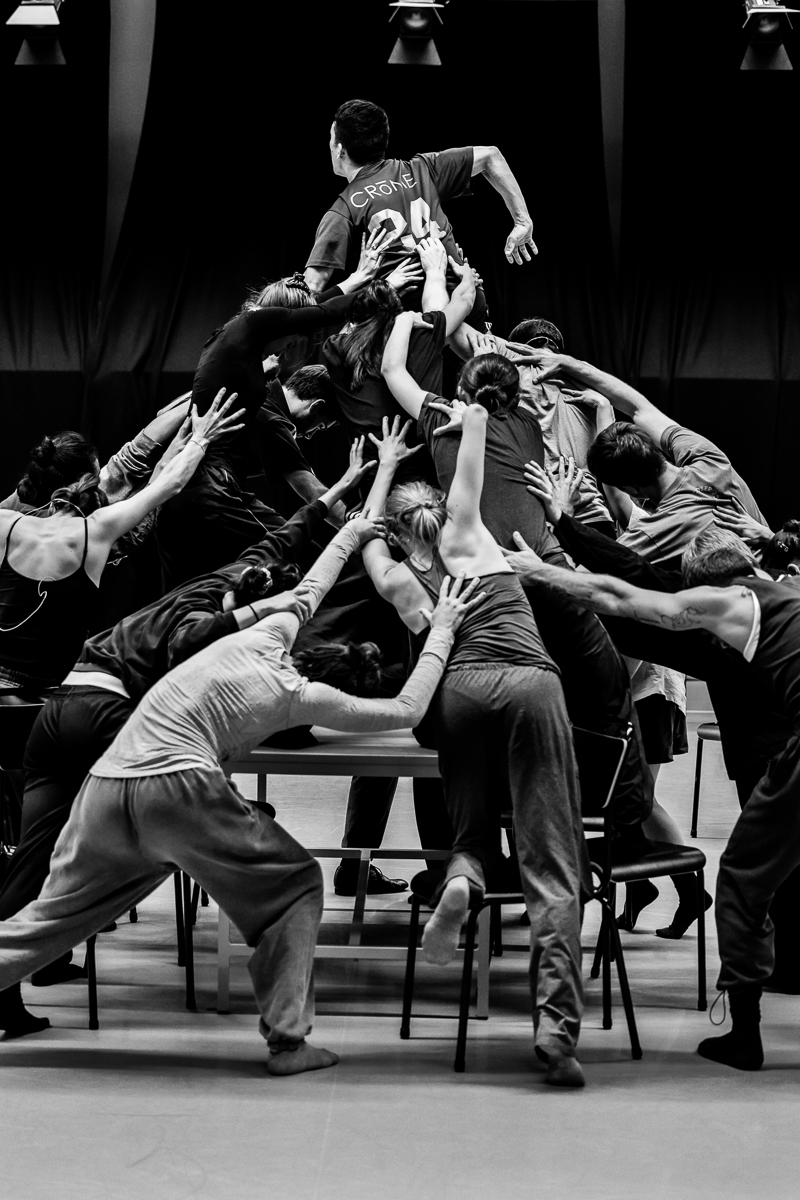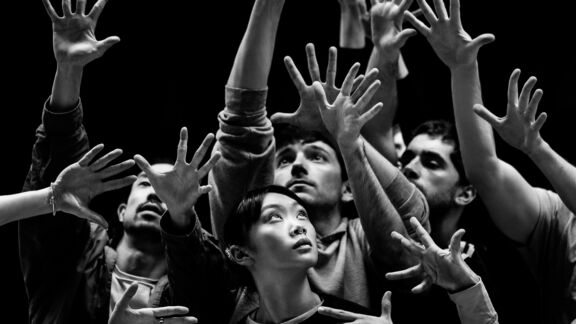Onderstaande tekst is een vrije Nederlandse vertaling die we hebben geschreven voor het publiek
De verdeling van het brein is niet iets waar neurowetenschappers graag meer over praten.
Het genoot een zekere populariteit in de jaren zestig en zeventig, na de eerste gespleten brein operatie. Het leidde tot een soort popularisering, waarvan sindsdien is bewezen dat deze volkomen onjuist is.
Het is niet waar dat een deel van het brein redeneert en het andere deel emotie verzorgt; beide zijn diep bij elkaar betrokken. Het is niet waar dat taal zich alleen in de linkerhersenhelft bevindt, dat is niet het geval, belangrijke aspecten bevinden zich in de rechterhersenhelft. Het is niet waar dat visualisatie alleen in de rechterhersenhelft is; een groot deel ervan bevindt zich in de linkerhersenhelft.
En dus, in een soort vlaag van wanhoop, heeft men het gesprek erover opgegeven. Maar het probleem zal echt niet weggaan want dit orgaan – dat draait om het maken van verbinding – is diep verdeeld. Het zit in ons allemaal. En het is in de loop van de menselijke evolutie steeds meer verdeeld geworden – de verhouding tussen het corpus callosum en het volume van de hersenhelften is kleiner geworden.
Het verhaal wordt nog ingewikkelder als je beseft dat het een van de belangrijkste, als niet de belangrijkste functie van de corpus calossum is feitelijk het remmen van de andere hersenhelft.
Dus, iets erg belangrijks is hier gaande over het gescheiden houden van dingen.
Waar gaat dat allemaal over? Wat zijn ze aan het doen?
Nou, hebben niet alleen wij deze verdeelden hersenen; vogels en dieren hebben ze ook.
Ik denk dat de makkelijkste manier om er over na te denken is als je een vogel voorstelt die probeert een zaad te eten, tegen een achtergrond van gruis en kiezels. Het moet zich nauwkeurig en duidelijk focussen op dat kleine zaadje en het kunnen uitkiezen uit die achtergrond. Maar ook, als het in leven gaat blijven, moet het eigenlijk een ander soort aandacht open houden, het moet uitkijken voor roofdieren.
En het lijkt dat vogels en dieren best betrouwbaar hun linkerhersenhelft kunnen gebruiken voor deze nauwkeurige aandacht voor iets waarvan ze al weten dat het belangrijk is, en hun rechterhersenhelft algemeen waakzaam houden, voor wat er ook gebeurt.
En ze gebruiken ook hun rechterhersenhelft voor het maken van connecties met de wereld, dus benaderen ze hun partners en verbinden ze met hun partners meer doormiddel van de rechterhersenhelft.
Maar dan heb je het over de mensen. En het is waar dat eigenlijk in mensen ook deze soort aandacht één van de grote verschillen is. De rechterhersenhelft geeft aanhoudende, brede, open, waakzame alertheid, terwijl de linkerhersenhelft smalle, scherp gerichte aandacht voor detail geeft.
Maar mensen zijn anders. Het grote ding over mensen zijn hun frontale kwabben. En het doel van dat deel van de hersenen? Om de rest van de hersenen te remmen, om de onmiddellijke gebeurtenis te stoppen; dus een stap terug in tijd en ruimte, weg van de directheid van de ervaring. En dat stelt ons in staat te doen waar neurowetenschappers ons altijd over vertellen waar we heel goed in zijn, namelijk de andere partij te slim af zijn. Machiavellistisch zijn. We kunnen de gedachten en bedoelingen van andere mensen lezen en, als we dat willen, kunnen we ze misleiden.
Maar wat hier altijd merkwaardig over het hoofd is gezien, is dat het ons ook in staat stelt om ons in te leven, omdat er een soort noodzakelijke afstand tot de wereld bestaat. Als je er recht tegenover staat, bijt je gewoon. Maar als je een stapje terug kunt doen en ziet dat een ander individu een individu is zoals ik, die misschien dezelfde interesses, waarden en gevoelens heeft als de mijne, dan kun je een band opbouwen.
Dus, de afstand tot de wereld die geboden wordt, is dus een diepgaande creatie van alles wat menselijk is.
Nu, om de machiavellistische dingen te doen, gebruiken we onze linkerhersenhelft. Om de wereld te manipuleren, wat heel belangrijk is, moeten we het kunnen gebruiken, interacteren met de wereld – en deze in ons voordeel gebruiken. Voedsel is het uitgangspunt. Maar we grijpen ook met onze linkerhersenhelft dingen vast (met onze rechterhand) en maken gereedschappen.
We gebruiken dat deel van de taal ook om dingen te begrijpen zoals we ze zeggen – het legt ze vast.
Dus als we al weten dat iets belangrijk is en we er precies over willen zijn, gebruiken we onze linkerhersenhelft op die manier.
Dit is dus erg interessant. En het verandert de kijk op het lichaam. Het lichaam wordt een samenstel van delen in de linkerhersenhelft.
De rechterhersenhelft is altijd op zoek naar dingen die anders kunnen zijn dan onze verwachtingen. Het begrijpt individuen, niet alleen categorieën. Het heeft eigenlijk een aanleg voor de levenden, in plaats van voor het mechanische.
Laat me het heel duidelijk maken; voor verbeelding heb je beide hersenhelften nodig. Laat me het duidelijk maken; voor redenatie heb je beide hersenhelften nodig.
Dus als ik het zou moeten samenvatten, zou ik zeggen dat de linkerhersenhelft, afhankelijk van denotatieve taal en abstractie, helderheid en kracht biedt om dingen te manipuleren die bekend, vast, statisch, geïsoleerd, gedecontextualiseerd, expliciet en algemeen van aard zijn. Maar uiteindelijk levenloos.
De rechterhersenhelft in contrast levert een wereld op van individuele, veranderende, evoluerende, onderling verbonden, impliciete, geïncarneerde levende wezens binnen de context van de geleefde wereld, maar in de aard van de dingen nooit volledig begrijpelijk, nooit perfect gekend en voor deze wereld bestaat het in een bepaalde relatie.
En het is mijn suggestie aan u dat in de geschiedenis van de westerse cultuur dingen begonnen met een prachtige balans tussen deze hersenhelften, maar dat in beide gevallen, het verder afdreef naar het standpunt van de linkerhersenhelft.
De kennis wordt bemiddeld door de linkerhersenhelft binnen een besloten systeem. Het heeft het voordeel van perfectie, maar de perfectie is behaald uiteindelijk ten koste van leegte.
We leven in een wereld die paradoxaal is. We streven naar geluk en het leidt tot rancune en het leidt tot ongeluk en het leidt, in feite, tot een explosie van geestesziekte.
In onze moderne wereld, de zogenoemde eerste wereld, hebben we iets ontwikkeld dat erg lijkt op de wereld van de linkerhersenhelft. We prioriteren het virtuele over het echte. Meer informatie – we hebben er genoeg van maar we kunnen het minder en minder gebruiken, begrijpen en wijs zijn. Het technische wordt belangrijk. Bureaucratie bloeit op.
Het beeld is gefragmenteerd. Er is een verlies aan uniciteit. Het hoe is ondergebracht in wat. En de behoefte aan controle leidt tot een paranoia in de samenleving dat we alles moeten overheersen en controleren. Ons dagelijkse leven is meer onderworpen aan een netwerk van kleine gecompliceerde regels dat het oppervlak van leven bedekken en vrijheid wurgt.
Ook denk ik, veel belangrijker, er is een soort spiegelzaal-effect; hoe meer we ons erin laten verstrikken, hoe meer we ondermijnen en ironiseren dingen die misschien ons eruit kunnen leiden. We krijgen terug gereflecteerd meer van wat we al weten over wat we al weten.
Het bleek dat Einstein’s denken op een of andere manier voorspelde over de structuur van het brein. He zij, “de intuïtieve geest is een heilig geschenk en de rationele geest is een trouwe dienaar”.




